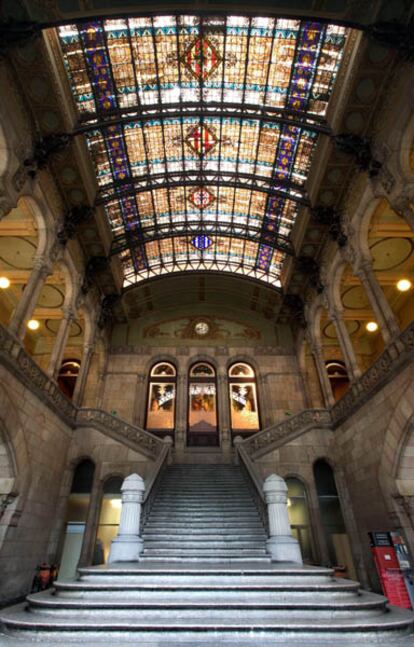In the city of Sagnier
Until now, Barcelona has neglected the memory of its most prolific architect
The black and white image immortalized the bullet impact against a mirror at the American Bar inside the former Hotel Colón, on the corner of Paseo de Gràcia and Plaza de Catalunya. It was July 1936, and the hotel, until recently a meeting point for artists, intellectuals and bohemians, was about to be turned into the headquarters of PSUC, a Catalan communist party.
Hotel Colón, which was eventually destroyed by the bombs during the Civil War and finally razed in 1942, was the work of the architect Enric Sagnier, one of the leading creators of modern-day Barcelona. For some reason, until now at least, history has not given him enough credit. CaixaForum now seeks to set things right with an exhibition called La ciudad de Sagnier. Modernista, ecléctica y monumental, (Sagnier's city: modernist, eclectic and monumental).
Through photographs, maps and just a few blueprints, the show provides a 360-degree look at an intense career that produced over 450 buildings between 1881 and 1931. "He was greatly valued in his time, he won many prizes and Pope Pius XI named him a marquis because of the large amount of schools and churches that he built for free," recalls his grandson Antonio Sagnier, who has made it his mission to revive his grandfather's fame.
In Gaudí's shadow
"As Gaudi's fame rose, [Sagnier's] work fell into the shade. In fact, he was offered the Casa Milà project first, but it was finally awarded to Gaudí because he was cheaper.
"For some families he built their homes, their office, their children's school and even their pantheon," adds Antonio Sagnier. A map of the neighborhood of Eixample showing Sagnier-built homes provides proof of his omnipresence, as well as his collaboration with the best builders and artisans in the city. And even though he was not such a Catalan nationalist as other modernist architects, he was one of the founders of the Cercle de Sant Lluc, a Catalan artistic association. He also had a great sense of state, evident in a monumental, iconic type of architecture that reflected the values of the Catalan bourgeoisie.
"Perhaps he was not a great structural innovator, but he incorporated all the technological innovations and new materials like concrete," notes Santi Barjau, the co-curator of the show. Two of Sagnier's most emblematic buildings are the temple of Tibidabo and the Justice Palace.
La ciudad de Sagnier. Until January 8 at CaixaForum. Av. Francesc Ferrer i Guàrdia, 6-8, Barcelona. http://obrasocial.lacaixa.es

Tu suscripción se está usando en otro dispositivo
¿Quieres añadir otro usuario a tu suscripción?
Si continúas leyendo en este dispositivo, no se podrá leer en el otro.
FlechaTu suscripción se está usando en otro dispositivo y solo puedes acceder a EL PAÍS desde un dispositivo a la vez.
Si quieres compartir tu cuenta, cambia tu suscripción a la modalidad Premium, así podrás añadir otro usuario. Cada uno accederá con su propia cuenta de email, lo que os permitirá personalizar vuestra experiencia en EL PAÍS.
¿Tienes una suscripción de empresa? Accede aquí para contratar más cuentas.
En el caso de no saber quién está usando tu cuenta, te recomendamos cambiar tu contraseña aquí.
Si decides continuar compartiendo tu cuenta, este mensaje se mostrará en tu dispositivo y en el de la otra persona que está usando tu cuenta de forma indefinida, afectando a tu experiencia de lectura. Puedes consultar aquí los términos y condiciones de la suscripción digital.
Últimas noticias
Maduro pleads not guilty before the federal court in New York: ‘I am still the president of Venezuela’
A new test can detect Alzheimer’s from a finger prick
UN team enters Sudanese city of El Fasher after paramilitary massacre: ‘It’s like a ghost town’
A recipe for resistance: Indigenous peoples politicize their struggles from the kitchen
Most viewed
- Gilles Lipovetsky: ‘If you want to live better and fall in love, take Prozac, don’t look to philosophy’
- Alain Aspect, Nobel laureate in physics: ‘Einstein was so smart that he would have had to recognize quantum entanglement’
- Maduro’s downfall puts China’s relationship with Venezuela to the test
- Why oil has been at the center of Venezuela-US conflicts for decades
- Alvin Hellerstein, a 92-year-old judge appointed by Bill Clinton, to preside over Maduro’s trial in New York








































